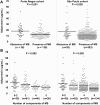Major components of metabolic syndrome and adiponectin levels: a cross-sectional study
- PMID: 24568287
- PMCID: PMC3941563
- DOI: 10.1186/1758-5996-6-26
Major components of metabolic syndrome and adiponectin levels: a cross-sectional study
Abstract
Background: Adiponectin is a major regulator of glucose and lipid homeostasis by its insulin sensitizer properties. Since decreased insulin sensitivity is linked to metabolic syndrome (MS), decreased adiponectin levels may be related to its development. The purpose of the study was to investigate the relationship between adiponectin levels and MS.
Methods: Firstly, we cross-sectionally examined subjects with or without MS submitted to an oral glucose tolerance test at Hospital de Clínicas de Porto Alegre (n = 172). A replication analysis was performed in subjects (n = 422) undergoing cardiac angiography at Hospital São Paulo. Subchronic inflammation (US-CRP), coagulation marker (fibrinogen), insulin sensitivity and resistance (Matsuda ISI and HOMA-IR) were estimated. Plasma total and high molecular weight (HMW) adiponectin were measured.
Results: Total and HMW adiponectin levels were lower in MS subjects (P < 0.05). Total adiponectin levels were lower in the presence of high waist circumference, low HDL-cholesterol and elevated triglyceride criteria in both samples and by elevated blood pressure and glucose criteria in Porto Alegre. HMW adiponectin levels were lower in the presence of low HDL-cholesterol, elevated triglycerides, and glucose criteria. Total adiponectin levels were positively related with HDL-cholesterol and ISI Matsuda, negatively related with waist circumference, glucose, triglycerides, HOMA-IR, and US-CRP and not related with blood pressure. While adjusting for sex and age, increased adiponectin levels remained associated with a reduced prevalence ratio for MS in both cohorts (P = 0.001).
Conclusions: Adiponectin levels decreased with increasing number of MS criteria, and it is in part determined by its relationship with HDL, triglycerides and abdominal adiposity.
Figures


References
-
- WHO. Book Obesity: Preventing and Managing the Global Epidemic of Obesity. Geneva, Switzerland: World Health Organization; Reprinted 2004. Obesity: preventing and managing the global epidemic of obesity.
-
- Malik S, Wong ND, Franklin SS, Kamath TV, L'Italien GJ, Pio JR, Williams GR. Impact of the metabolic syndrome on mortality from coronary heart disease, cardiovascular disease, and all causes in United States adults. Circulation. 2004;110:1245–1250. doi: 10.1161/01.CIR.0000140677.20606.0E. - DOI - PubMed
-
- Alberti KG, Eckel RH, Grundy SM, Zimmet PZ, Cleeman JI, Donato KA, Fruchart JC, James WP, Loria CM, Smith SC Jr. Harmonizing the metabolic syndrome: a joint interim statement of the International Diabetes Federation Task Force on Epidemiology and Prevention; National Heart, Lung, and Blood Institute; American Heart Association; World Heart Federation; International Atherosclerosis Society; and International Association for the Study of Obesity. Circulation. 2009;120:1640–1645. doi: 10.1161/CIRCULATIONAHA.109.192644. - DOI - PubMed
LinkOut - more resources
Full Text Sources
Other Literature Sources
Research Materials
Miscellaneous

